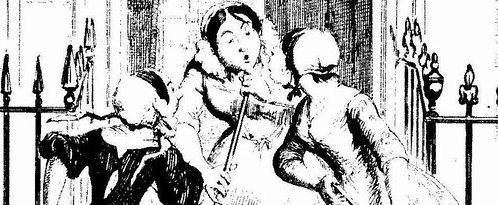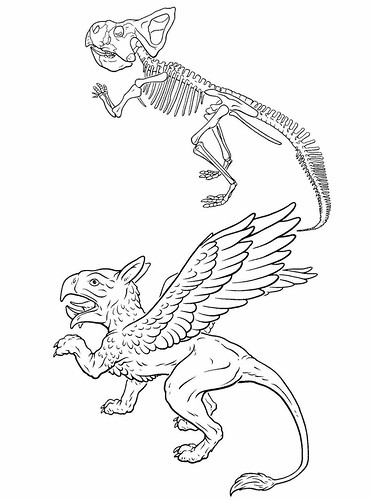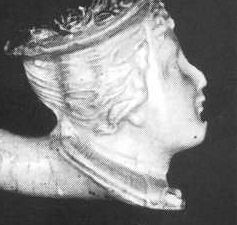Those ancients weren't dumb
Lots of bloggers are now compiling their "Best Books of 2004". I don't think I can manage that - just finding them all would take ages, and judging them, well... see you some time in 2006.
But I am going to put up a couple of posts on my most interesting surprising, "whow" books of 2004, one of which was The Fossil Hunters, by Adrienne Mayor, 2000, Princeton University Press.
Above is page 44, showing a reconstruction of the skeleton of a Protoceratops, a dinosaur that lived in what is now the Gobi desert. Below is a Scythian "griffin", placed into the same stance.
This very clear example is used to introduce the idea that the account of griffins was transmitted initially orally, by the Scythian nomads who found these skeletons, quite often whole, and sometimes with nests of eggs, in the desert, then written down by the Greeks.
But furthermore the Greeks and Romans encountered fossils for themselves and their texts "contain some of the world's oldest written descriptions of fossil finds, many of them first hand. Writers like Herodotus, Pausanias and Aelian tell us what they and their contemporaries thought, said, and did when they came upon bones of startling magnitude." (p. 52)
Mayor suggests that these discoveries - still being made in many parts of the Classical lands - provided the grounds for "myths" about enormous ancient heroes and great monsters.
So, in about 560BC, the oracle at Delphi told the Spartans they needed to find the bones of the hero Orestes before they could defeat their regional rival, Arcadian Tegea. Herodotus says that by chance a Spartan cavalryman stumbled across, then stole, the bones found in a "huge coffin", more than 10 foot long, containing bones of a matching size. The suggestion is that these were the remains of a mammoth, found in the 7th-century BC, when the cult of heroes had begun, and given the coffin burial. A century or so later they were rediscovered, and gave the Spartans the confidence to dominate the Peloponnese.
This led to a long-lasting "Panhellenic bone rush". (p. 111)
But in many cases finders and searchers understood they were looking at animal bones. Mayor argues the famous "Monster of Troy" vase in fact shows a fossil skull eroding from a cliff.
Image here.
This knowledge led the Romans to something approaching a theory of evolution. Lucretius, writing in the 1st century BC, wrote the nature produced "many monsters of manifold forms" and "bigger animals" in ages past, but these gradually died out when they could not find food or reproduce. "everything is transformed by nature and forced into new paths. One thing dwindles ... another waxes strong." (p. 216)
Finally, going far, far further back, it seems humankind always found something special in fossils: Jurassic ammonites were pierced for suspension by Cro-Magnons in France and a Pliocene gastropod was found in the Lascaux Cave in France; it must have come from either the Isle of Wight or Ireland - a treasured item. (p.. 166)
This is a frustratingly badly written and organised book - it cries out for a decent editing job - but it is well worth the irritation for the ideas and knowledge it contains.








5 Comments:
great post - i've read a similar article about the Giant/Mammoth skeleton confusion, possibly in national geographic. the griffin homology is startling, especially considering the eggs and consequent addition of wings to the mythology. good luck in the bloggies - a word of caution - the results rarely reflect merit!
Thanks for the compliment. As for the Bloggies, I'm not holding my breath, but it seems like you might as well have a go, and having started this blog with no particular intention in mind I'm now thinking it would be nice to build up its readership, so .... (And I've been following with interests your excursions in the area!)
My the blogosphere is fun. Linked to you by the brand new Early Modern Notes (History Carnival), who have a blurb on your book review about the (very) early dinosaur hunters. They in turn were linked to by the famous Glenn Reynolds of Instapundit, 14 January. Most interesting article. Thanks. Gerry
You forgot to mention this little chestnut: Cyclops = Wooly Mammoth Skull.
P.S. I linked to you on my brand new blog.
The mammoth skull angle is indeed interesting - in fact this linkage goes back quite a long way. Quoting from p 35: "In 1914, Othenio Abel, an Austrian paleontologist, suggested that the Cyclops of Homeric legend was based on fossil elephant finds in antiquity. Abel, who excavated many Mediterranean fossil beds, related the image of one-eyed giant cavement to the remains of Pleistocene dwarf elephants, common in coastal caves in Italy and Greece. Shipwrecked sailors unfamiliar with elephants might easily mistake the skull's large nasal cavity for a central eye socket."
Post a Comment
<< Home